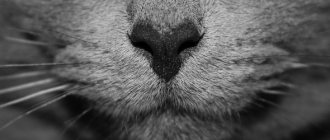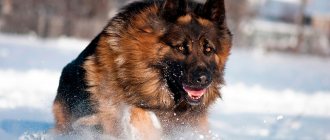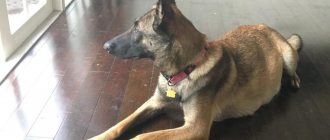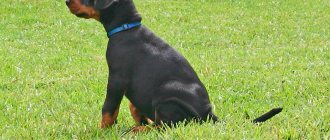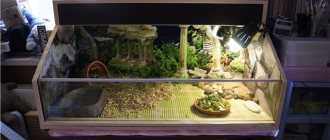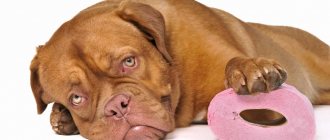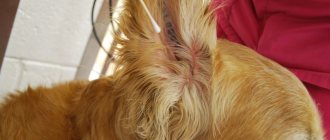Anatomical features
The dog's nose is almost always wet and cool. The famous zoologist Knut Schmidt-Nielsen put forward his theory of why dogs have wet noses. He claims that our four-legged friends do not have sweat glands, and a wet nose saves them from overheating.
During rapid breathing in extreme heat, the dog sticks out its tongue, thus increasing cooling. At this time, the nose takes an active part in heat exchange. The mucus that is constantly secreted helps a moist nose to detect odors.
Therefore, it is the dog that has an excellent sense of smell, thanks to which it orients itself in space. Naturally, the loss of this opportunity will affect the dog’s behavior.
Development of a dog's sense of smell
Ability to remember smells
Research by scientists has proven the fact that dogs can not only smell smells, but also remember them very well and for a long time. For example, if a dog was once offended by a person in some way, it is able to remember his smell for many years. If you meet this person again, don’t expect any favors; she definitely won’t show him friendliness.
Ability to distinguish odors from a distance
Dogs have a remarkable ability to detect odors, even when moving away from an object at short and very long distances. There have been cases where a dog found people who were 150 km away from it. Of course, in such unique cases, the wind blows towards the dog and gives it data. However, this ability is unique.
Possessing an “analytical sense of smell”
Dogs have the ability to separate odors into groups. Even people can distinguish only 2-3 odors from one aroma, but a dog can identify about 10 odors, distributing each one into its own groups and distinguish the one among them in order to take a scent.
NOTE! A lost dog will always come home, because during the journey from home it constantly sniffs and smells are stored in its memory.
It’s not for nothing that dogs are taken with them on hunts, because their sense of smell unmistakably identifies hare tracks, and indeed any game.
Normal condition
In a healthy state, the nose should be cool, because when the temperature rises, the mucous membrane quickly dries out and cannot produce secretions. There is an opinion that if a dog’s nose is hot, and not cold and wet, then the pet is not entirely healthy. However, such a condition does not necessarily indicate the presence of malaise.
Why under some circumstances the nose can be dry - you will learn about this further.
So, puppies have a dry nose both after active pastime and after sleep. Some time after waking up, the nose becomes wet. Sometimes a dog encounters something and the secretion production is disrupted, and as a result, the nose becomes dry. After a while, secretion production resumes and the condition of the nose will become normal. If the animal is tired, the condition of the mucous membrane worsens. After rest, everything returns to normal.
A high temperature of the mucous membrane indicates that the animal has a fever. This could be a viral infection, injury, or an inflammatory process in one of the organs. If the pet is lethargic, constantly drinks, does not want to eat, is irritable, and is looking for a secluded place so that everyone will leave it alone, this is an alarming signal. The dog is sick and needs hospitalization. Try taking your temperature. Different breeds of dogs may have different normal parameters.
Before visiting a veterinary hospital, your pet's condition can be improved. Constant access to water must be provided. During viral infections, the animal must drink a lot. In winter, you can apply a cotton swab dipped in water or saline solution to your nose. Treating your nose with fresh aloe juice will have a good effect.
On the eve of an examination by a veterinarian, you should not give your dog any medications, as the clinical picture of the disease will be blurred.
During allergic reactions, the nose may also be dry. One possible reason is a plastic feeding bowl. It is best to buy a stainless steel bowl for your pets. The reaction can also be caused by the flowering of indoor plants - in this case the plant should be taken out of the apartment.
It is almost certain that a potential dog breeder is fully aware that the dog's nose should be exceptionally cool and moist. Any deviations are often mistaken for one of the symptoms, simply of the dog’s malaise. Is this so, and yet, what kind of nose a healthy dog should have, we will consider below.
Cold nose on a dog
Have you ever wondered why it is generally accepted that a wet and cool nose is normal for a pet? The thing is that an animal does not have the ability to sweat like a person. And the nose is precisely the mucous membrane that secretes secretions in order to balance the thermal balance. For the same reason, during periods of extreme heat, dogs and cats stick out their tongues: you and I take off excess clothing, they also provide a larger area of mucous membrane for secretion.
Therefore, it is generally accepted that a dog’s nose should be extremely cold and always wet. But, just like in humans, deviations from the accepted norm do not always mean the onset of illness or illness in the pet. This largely depends on the age and breed of the dog, its individual characteristics, activity and lifestyle.
For example, for puppies or some breeds a little is quite normal after active play, sometimes after sleep or a state of rest. Sometimes the nose remains wet but warm. Many chronic diseases affect the normal state of the pet’s mucosa, and this is not necessarily within the framework of accepted norms; here you will consider individual changes specifically for your dog.
Please note if the dog’s nose remains a little wet and cold, but the mucous membranes have changed color. It is the change of color that should attract your attention more than dryness. By the way, we often wonder what kind of nose a healthy dog should have, but we don’t notice other aspects. For example, wheezing, sniffling, and sneezing are accompanied by a completely normal state of the mucous membrane, although the animal is sick. On the contrary, a completely healthy dog walks with a warm nose. Many animals react in this way to changes in temperature, sudden changes in air humidity, or active games in the fresh air. This is why a cold nose in a dog with characteristic dampness is not a guarantee of health. Typically, breeders recommend observing the dog’s behavior, any changes in its usual routine, and drawing conclusions based on this. So it is not always correct to perceive the nose as an indicator.
If a dog has a cold nose, then its moisture indicates good health. This is quite natural. The sense of smell is the dog’s main receptor, with the help of which it navigates the world around it. It is so strong that the animal can easily detect even a faint odor at a distance of more than 100 meters. Thus, a four-legged pet becomes an excellent assistant for humans, for example, in searching for explosive substances or drugs. The dog's nose simultaneously acts as a respiratory and olfactory organ. In addition, it is a “barometer” in determining the healthy state of the animal.
Hot and dry
Too high a temperature in the nasal mucosa is almost always combined with dryness. This symptom always indicates a disease that causes fever. The reasons for this include infectious pathology or significant trauma, as well as an inflammatory process. First of all, it is important to make sure that the dog is not experiencing heatstroke.
Immediate contact with a veterinarian is necessary in cases where a hot and dry nose is combined with the following symptoms:
- weakness, lethargy and sleeping longer than usual;
- constant desire to drink;
- loss of appetite;
- increased irritability and aggression;
- the dog tries to hide in a secluded place where no one will disturb him;
- obvious intestinal disorders (diarrhea, vomiting);
- swelling of the nose;
- blisters and peeling on the mucous membrane;
- frequent sneezing and paroxysmal cough, runny nose;
- hoarse voice.
It's good if the dog can measure the temperature. The values for this parameter differ for dogs of different ages and sizes, and also change in pregnant or lactating bitches.
Why is my dog's nose wet and cold?
The dog's nose has a rather complex and interesting structure, which consists of a top, back, side parts and root. It is on that part of the nose (the apex) where there is no hair that the serous glands are located, thanks to which the surface of the earlobe is cold and wet to the touch.
Studies have shown that there are many receptors in a dog’s nose, with the help of which the animal is able to accurately determine the smell and its place of origin. The mucus on the nose can hold some odors so that others can get into the depths of the nose.
Also, the humidity of the nose is necessary in order to determine the direction of movement of the air that carries odors. Even a person, having wet his finger and raising it up, uses this method to determine the direction of the wind. Signs of a healthy pet:
- Thick and richly colored coat. The dog sheds twice a year for one month;
- No pus or redness in the eyes;
- Wet and cold nose. After the dog has awakened from sleep, the nose may be slightly dry and warm. This happens because the animal's body temperature rises during sleep. Many novice dog breeders are not used to thinking about why the dog’s nose is cold and wet. The reason for this is the almost complete absence of sweat glands, which are located only on the surface of the nose and in the oral cavity. Thanks to these glands, the dog cools its body and body;
- Changes in the color of the tongue and mouth indicate health problems;
- Smooth breathing. In a healthy state, the dog takes approximately 15 - 25 breaths in and out for one minute. The exceptions are small breeds, puppies, and pregnant women. No hoarseness or cough;
- A dog's normal body temperature is 37 - 39 degrees.
Why is the dog's nose so cold, given the animal's high temperature? This is because the sweat released during evaporation cools the tip of the nose, thereby helping to maintain a normal temperature throughout the body.
To measure your pet's temperature, use a thermometer that is inserted into the anus. Three minutes is enough for this.
Cold nose
A too cold surface of the lobe may be a sign of a significant decrease in the animal’s body temperature. The rest of the body is covered with fur, so it is the nose that gives an idea of the coolness of the skin.
There are several reasons for this phenomenon:
- hypothermia;
- colds or viruses;
- serious malfunctions in the functioning of internal organs.
In this case, the main signals indicating that the dog urgently needs to be shown to a specialist are:
- dull or watery eyes;
- bloodless gums;
- cold surface of the ears;
- wheezing.
Causes of a dry nose in a pet
We have found that a dog's cold nose indicates good health. But a dry nose can be a sign of illness. Possible reasons for this phenomenon may be the following:
- Cold. In addition to a dry nose, other signs of illness may appear. Among them: coughing, sneezing.
- After complete recovery, the dog's nose will return to its usual moist state;
- Allergy. A variety of objects and factors can act as irritants, ranging from lilac blossoms to plastic eating utensils. To determine the allergen, you should carefully monitor your pet's behavior and gradually eliminate possible pathogens. There are also tests to solve this problem;
- Nose injury. You can determine it yourself, but it is better to contact a specialist; Pemphigus is an autoimmune disease. Signs of the disease are the appearance of small blisters not only on the nose, but sometimes on other parts of the body. After they burst, a characteristic crust begins to form on the surface of the nose. Histology can confirm this disease.
- A dry nose can be a consequence of dehydration. So be sure to refill your pet's water bowl regularly.
- Weather factors (extreme heat, frost, dry air) can affect the condition of the dog’s nose.
What measures should you take if your nose is dry?
If you use a plastic feeding bowl, it must be replaced with a metal or glass one. Keep utensils clean;
- In spring, avoid flowering plants while walking.
- If you have a high temperature, do not delay visiting the veterinarian;
- For preventive purposes, you can sometimes lubricate your nose with calendula.
- Experts recommend that pet owners pay attention to and monitor the behavior of their pet.
- Changes in his habits can give a good clue to recognizing the disease.
Serious problems can arise when a dog's nose becomes not only dry, but also hot. This means that the animal has a fever. Other symptoms may also appear: weakness, thirst, lethargy, indifference to food. The situation can be especially dangerous if your pet is still just a puppy. It is necessary to immediately seek help from a veterinarian and take measures to recover your dog. There are often cases that the disease can lead to death. If no additional symptoms are observed, then the pet may have overheated in the sun.
What does a dog's very cold nose indicate?
If your pet's nose is cold and wet to the touch, then this is a clear sign of a low body temperature.
The reasons can be varied: normal hypothermia, illness. Examine your pet carefully. If any abnormalities are detected (dull eyes, cold ears, pale gums), immediately seek help from a specialist. There is a possibility of a disruption in the functioning of the dog’s organs.
Based on the above, now you know why a dog’s nose is so wet and cold, and what needs to be done if its usual state changes. Of course, it is impossible to determine what your pet is sick by looking at the nose, but this greatly helps prevent possible serious illnesses. Most importantly, do not forget to keep an eye on your four-legged friend.
About the author: Anna Aleksandrovna Maksimenkova
Practicing veterinarian in a private clinic.
Directions: therapy, oncology, surgery. Read more about me in the “About Us” section. Eyes
A healthy dog has clear, shining eyes that do not water or have discharge. Eyelashes and hair should not touch the eyeball; owners of long-haired dogs should especially take this into account. By placing your thumb on the edge of the eyelid and gently pulling the eyelid down or up, check the moist, pink inner side of the eyelids (conjunctiva). It should be smooth, without inflammation, swelling or yellowish discharge. The whites of the eyes should not have a yellowish tint. In the inner corner of the dog’s eye there is a “third eyelid” - a light pink membrane. It looks different on the surface of the eye in different breeds.
The skin on the inside of the ears is light pink, clean and covered with sparse hair. There may be some yellow, brown, or black wax in the ear canals, but excessive amounts are abnormal. The outer side of the ear is covered with thicker hair, like the rest of the body. Healthy ears do not emit a bad odor, there is no redness or swelling, they do not itch, do not hurt, and do not have discharge.
Mouth, teeth, gums
To examine a dog's mouth or teeth, grasp one side of it with your thumb and the other with your fingers. Holding the dog's head in this way with one hand, pull down the lower or upper jaw with the other.
Healthy teeth and gums
Healthy gums are pink or pigmented (black or mottled) and firm to the touch. The edges of healthy gums surround the teeth, which should be free of soft or hard white plaque, yellow or brown material. When breathing, the dog should not emit an unpleasant odor.
Young dogs' teeth are white and smooth, darkening with age. On average, puppies have 23 baby teeth and no molars. Adult dogs usually have 42 permanent (molar) teeth, although some breeds may have fewer due to their jaw structure.
Baby teeth should not remain when permanent teeth emerge, and sometimes they have to be removed.
The dog may have a scissor bite (the upper front teeth extend slightly beyond the lower teeth), an undershot bite, or an overshot bite. The breed standard specifies which type of bite is preferred for a given breed.
A dog's nose is usually cold and wet. Nasal discharge should be clear and watery. The most common is a black nose, although a variety of colors and even spots are normal. The nose should not be red or irritated, which could indicate injury, illness, or sensitivity to sunlight.
Temperature
The normal range of temperature measured by a rectal thermometer for a dog is 38.3 - 39.2 ° C. To begin, shake the thermometer and lubricate its head with petroleum jelly, vegetable or mineral oil. Lift the dog's tail and carefully insert the thermometer into the anus to a depth depending on the dog's size. For a large dog this may be half the length of the thermometer, for a small dog it may be just an inch (2.5 cm). It is better to carry out the procedure when the dog is standing. After three minutes, remove the thermometer and check its readings.
Heartbeat and pulse
The heartbeat of a healthy dog depends on its size and condition. Typically, at rest, the heart beats at a rate of 50 to 130 beats per minute. In puppies and small dogs it beats more quickly, in large dogs and dogs in good physical condition it beats more slowly. To determine your heart rate, place your fingertips or palm of your hand on the left side of your dog's chest, behind the elbow, or place your ear to the chest above the heart. The pulse is checked by pressing on the artery located on the inside of the thigh where the leg articulates with the body.
Discharge
A healthy dog's urine is yellow and clear. An adult dog has bowel movements once or twice a day; The stool is well formed and usually brown. The amount of stool your dog produces and its color may depend on its diet. Large amounts of foul-smelling, runny, or unusually colored stool are abnormal.
Even if everything else is fine with your dog, if she is underweight or, more often, overweight, you cannot guarantee that she is completely healthy. Obesity is usually the owner's fault and can be treated by changing the dog's diet after a veterinarian has ruled out hormonal imbalances or other medical conditions.
The condition of a dog's nose will tell the owner of the animal a lot. This is a kind of indicator that signals any problems in the pet’s body. By carefully observing your pet, you can very quickly determine that he feels bad or, on the contrary, is healthy and full of energy. Any disease changes the appearance, temperature and humidity of the nose. Noticing signs of ill health in a timely manner will help you avoid many troubles and will tell you when you need to see a doctor.
Norm
A cold and wet nose in an adult dog or puppy is an indicator of normal health.
Why do these signs indicate good health:
- The dog has no sweat glands. A wet nose evaporates excess water instead. It also saves you from overheating in hot weather. When purchasing a puppy, it is important to pay attention to the condition of this organ.
- The mucus produced by the nose moisturizes it, preventing the skin from drying out, since the dog perceives the world 90% through smell.
When you don't need to worry
Some people believe that a warm, dry nose is a sign of illness. It is not always so. There is no need to worry in the following cases:
- In the morning, when the dog is sleeping or has just woken up. During sleep, all metabolic processes slow down.
- In hot weather. The fact that the dog is hot is indicated by its protruding tongue and rapid breathing. You can bathe your pet in cool water or wet his paw pads.
- During the heating season, when the air in the apartment is dry and warm.
- For minor trauma to the surface of the nose. A simple scratch can cause temporary dryness and increased temperature of a sensitive organ.
- During estrus in females. Hormonal surges can change the condition of the nose.
- After a long active walk. Physical overwork or fatigue affects the condition of the nose.
- When the weather changes. The dog's nose is sensitive to such indicators.
- When replacing baby teeth in puppies. The humidity and temperature of the nose becomes changeable.
- Under stress. Temporary dryness is observed in a healthy puppy that is brought into an unfamiliar home, but it quickly passes.
A warm and dry nose of a healthy dog, if it eats well
, plays and is not bothered by anything, is considered normal.
Some dogs live with this their whole lives.
If the nose is not just warm and dry, but hot, then we can talk about trouble in the pet’s body.
When can a healthy dog have a dry and warm nose?
Inexperienced dog owners begin to panic if their dog’s nose is warm and dry, sometimes bringing their pet in for examination almost every day.
In fact, there are many situations when the skin on the nose of a perfectly healthy dog can dry out and become warm:
- It is hot and stuffy in the room where the pet is kept. In addition, the same phenomena can be observed when walking in dry and hot weather. Bulldogs, which are distinguished by the specific structure of their nasopharynx, are especially susceptible to this.
- Stress.
- Great excitement. For example, before or after vaccination, a dog’s nose may dry out completely.
- The animal is very tired.
- In addition, dogs' noses dry out during sleep. If the dog has just woken up, the skin of the organ will definitely be dry, and there is nothing to worry about.
When to see a doctor
Before you panic, you need to observe your pet for a while. If the nose is dry and warm, and the ears are cold, then this is normal and means there is no fever. There is no reason to worry.
You should be alarmed by the animal's unusual behavior and additional signs of poor health.
Additional symptoms
A dog's dry, cracked and hot nose, coupled with other signs, indicates a disease. You need to sound the alarm when additional symptoms appear:
- drowsiness;
- apathy;
- lethargy;
- lack of appetite;
- nausea and vomiting;
- increased body temperature;
- discharge from the nose and eyes (including clear);
- cough and sneezing;
- diarrhea.
These manifestations signal an illness or painful condition. These are different concepts. In the summer, when it is very hot, and the dog does not have water in his bowl, he becomes apathetic and lethargic, his nose will be hot and dry. It is enough to give your pet something to drink for its condition to change.
Discharge from the nasal passages and eyes can indicate either a cold or an allergic reaction, for example, to the plastic from which the food bowl is made, or to pollen. Diseases that cause dryness and fever include:
Any dog illness is accompanied by dryness and increased temperature of the skin of the nose. It is important to notice the dangerous condition of your pet in time when urgent veterinary help is needed.
Poisoning
In some poisonings, the nose is not only hot, but also very cold. Body temperature drops sharply. An icy nose and cold ears may indicate chemical poisoning or a bite using venom if the following symptoms occur:
- nausea;
- vomit;
- salivation;
- weakness;
- trembling of limbs;
- drop in body temperature;
- violation of the respiratory rhythm - the dog breathes often or breathing is heavy and too slow;
- unusual odor from the mouth;
- pupil dilation.
In this case, emergency veterinary care is required.
If you are poisoned by chemicals or poisons, you should not try to treat your dog at home or save it yourself. She could die within a few hours. Immediate medical attention is required.
Food poisoning is usually accompanied by fever and diarrhea.
How to help your pet
In case of any poisoning, you should immediately remove the bowl of food, leaving the water.
If the dog refuses to drink on its own, you must forcefully inject it with 50-100 ml of water using a syringe or a medical bulb. A poisonous substance that enters the body orally will be diluted and cause less harm. No other solutions such as soda or potassium permanganate need to be used.
By pressing on the root of the tongue, you must try to induce vomiting, if you are sure that the poisoning is food, then do an enema and give activated charcoal - one tablet per 1 kg of weight.
If you suspect a chemical substance, you should not rinse your stomach.
This can damage the mucous membrane and cause stomach bleeding. All necessary procedures must be performed by a doctor, who must be contacted immediately. If your pet's body temperature drops, you should warm it up.
Dangerous diseases
Deadly viral diseases include canine distemper (distemper) and rabies. The fulminant form of distemper, especially in unvaccinated puppies, has no symptoms other than an increase in temperature - a hot nose and ears. Therefore, you need to immediately show the young dog to the doctor.
Distemper manifests itself with a variety of symptoms similar to a cold, poisoning or allergies. If they occur, you should immediately contact a veterinarian.
Rabies poses a great danger to humans. In dogs it occurs in different forms and is accompanied by various symptoms. The causative agent of the disease is a virus to which the animal’s body reacts with an increase in temperature. You should pay attention to the following behavior of your pet:
- the dog hides and does not respond to the call;
- drooling appears;
- difficulty swallowing;
- The dog makes grasping movements with its mouth.
These symptoms appear in the first 3 days after the onset of the disease. It takes about 3 months from the moment of infection to the first signs of the disease. At the slightest suspicion of rabies, you should immediately consult a doctor so as not to expose your health to mortal danger.
There is no cure for rabies in dogs.
The animal is quarantined to exclude contacts and monitored. Within 10 days the diagnosis is confirmed or excluded.
Pemphigus is a severe autoimmune disease. If papules and vesicles appear on your dog's nose, you should consult a doctor.
The sooner support for the body is started, the fewer areas of skin will be affected by the disease.
Help
If rabies is suspected, the dog is isolated indoors, taking measures to protect against bites, and a doctor is called.
Symptoms of distemper can appear even in a vaccinated dog. He may refuse food and water, become lethargic and apathetic. Treatment, unless otherwise prescribed by a doctor, consists of forced watering and feeding during a hunger strike of more than 2 days.
Meals should be fractional - 5-6 times a day. To do this, use lean ground beef, pushing small balls closer to the root of the tongue so that the pet reflexively swallows them.
If a dog sneezes, does it mean it is sick?
Many dog breeds sneeze when they are happy or excited, and this is completely normal. Whining can also cause sneezing. In general, sneezing can be caused by any irritant in the nose. Dogs will sneeze when they smell dust or a bad odor. Excess mucus from respiratory infections or sinus problems causes thick or harsh sneezing. A dog that is constantly sneezing for no apparent reason should be taken to the vet to see if he has something stuck in his nose (the nostrils can hide any number of small objects and growths, including warts or tumors). Never attempt to remove anything from a dog's nose yourself: the skin in the nose is very sensitive and prone to severe bleeding if cut.
